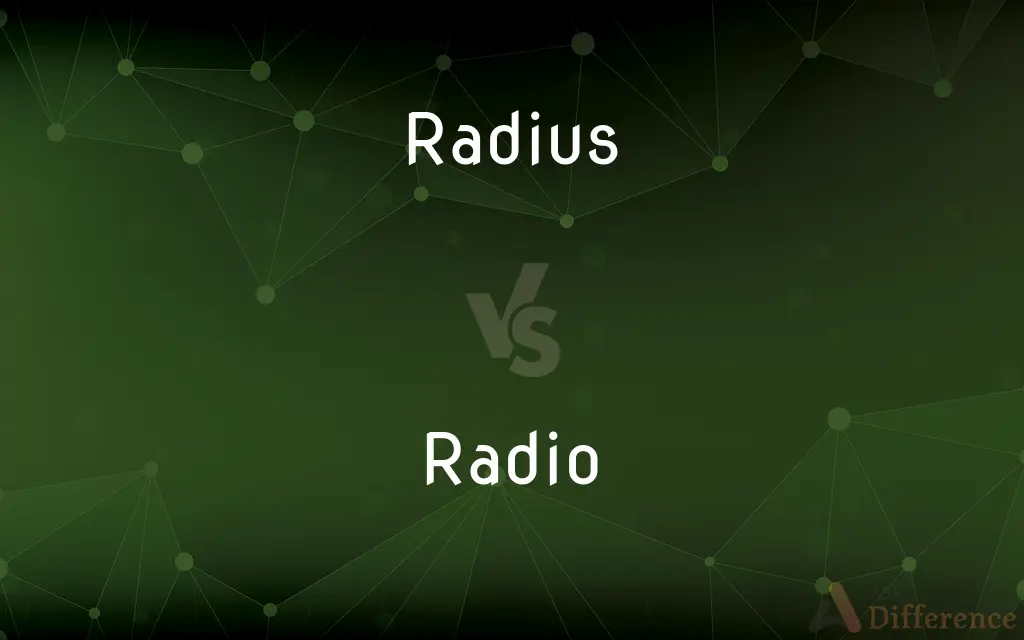Radius vs. Radio — What's the Difference?
By Urooj Arif & Fiza Rafique — Updated on April 20, 2024
Radius refers to a line segment from the center to the circumference of a circle, while radio is a technology for transmitting audio data via electromagnetic waves.

Difference Between Radius and Radio
Table of Contents
ADVERTISEMENT
Key Differences
Radius is a geometric term describing the distance from the center of a circle or sphere to any point on its edge. On the other hand, radio refers to a form of wireless communication that uses radio waves to transmit information, typically in the form of sound, without requiring a direct line of sight between the transmitter and receiver.
While the concept of a radius is pivotal in fields such as mathematics, engineering, and physics, particularly for calculating areas and volumes of circular objects, radio technology is fundamental in communications, broadcasting, and navigation systems. Radios convert transmitted electromagnetic waves into audio or other formats that can be understood by humans.
Radius is always half the diameter of the circle, providing a critical measure for various calculations and constructions in geometry. Conversely, radio systems involve components like transmitters, receivers, and antennas to handle the transmission and reception of signals over various distances.
In practical applications, the radius of an object might influence its design and functionality, such as wheels, rotors, and other circular components. Whereas, radio impacts everyday life through its use in media broadcasting, emergency communications, and wireless networking.
Radius is a static measurement and does not change unless the dimensions of the circle or sphere change. In contrast, radio technology has evolved significantly over time, moving from basic analog transmissions to complex digital and satellite communications.
ADVERTISEMENT
Comparison Chart
Definition
Distance from the center to the edge of a circle
Technology for transmitting sound or data via electromagnetic waves
Primary Field
Geometry
Communication Technology
Measurement
Linear distance
Involves frequency and wavelengths
Components
Center point, circumference
Transmitter, receiver, antenna
Practical Uses
Architectural design, machinery design
Broadcasting, communication, navigation
Compare with Definitions
Radius
Critical in the design and function of round objects.
Knowing the radius helps in designing gears and clock mechanisms.
Radio
Involves hardware like transmitters and antennas.
Emergency services use radio devices to communicate in crises.
Radius
Unchanging in a static circle or sphere.
The radius of a perfectly round basketball remains constant during play.
Radio
A technology for audio and data transmission over radio waves.
FM and AM are common types of radio broadcasting.
Radius
Measured in linear terms, such as centimeters or inches.
The radius of a pizza is 6 inches from its center to edge.
Radio
Uses electromagnetic waves to transmit information.
Radio waves carry music and news broadcasts without wires.
Radius
The half-length of the diameter of a circle.
The radius of a typical bicycle wheel is 35 cm.
Radio
Operates on various frequencies to manage bandwidth.
Different radio stations operate at specific frequencies to avoid signal interference.
Radius
A fundamental element in calculating the area and circumference of circles.
The area of a circle is π times the square of the radius.
Radio
Can transmit signals over vast distances.
Radio signals can travel from Earth to space crafts in outer space.
Radius
In classical geometry, a radius of a circle or sphere is any of the line segments from its center to its perimeter, and in more modern usage, it is also their length. The name comes from the Latin radius, meaning ray but also the spoke of a chariot wheel.
Radio
Radio is the technology of signaling and communicating using radio waves. Radio waves are electromagnetic waves of frequency between 30 hertz (Hz) and 300 gigahertz (GHz).
Radius
A line segment that joins the center of a circle with any point on its circumference.
Radio
Electromagnetic radiation with lower frequencies and longer wavelengths than those of microwaves, having frequencies lower than 300 megahertz and wavelengths longer than 1 meter.
Radius
A line segment that joins the center of a sphere with any point on its surface.
Radio
The transmission and reception of electromagnetic waves within this range, especially when convertible to audible sounds
The use of radio in warfare.
Radius
A line segment that joins the center of a regular polygon with any of its vertices.
Radio
A device, such as a walkie-talkie, that transmits or receives such signals.
Radius
The length of any such line segment.
Radio
The system or industry that broadcasts programs of audio content to the public or subscribers by means of radio waves or over the internet
She was famous during the early days of radio.
Radius
A circular area measured by a given radius
Every family within a radius of 25 miles of the city center.
Radio
Audio content, especially short programs or sets of songs, created for or distributed through such a system
Listening to radio.
Radius
A bounded range of effective activity or influence
The operating radius of a helicopter.
Radio
An electronic device for listening to radio programming, consisting of a tuner and speakers.
Radius
A radial part or structure, such as a mechanically pivoted arm or the spoke of a wheel.
Radio
To transmit by radio
Radio a message to headquarters.
Radius
A long, prismatic, slightly curved bone in humans, the shorter and thicker of the two forearm bones, located on the lateral side of the ulna.
Radio
To transmit a message to by radio
Radioed the spacecraft.
Radius
A similar bone in many other vertebrates.
Radio
To transmit messages or a message by radio
A ship radioing for help.
Radius
(anatomy) The long bone in the forearm, on the side of the thumb.
Radio
(uncountable) The technology that allows for the transmission of sound or other signals by modulation of electromagnetic waves.
Send a message by radio
Radius
(zoology) The lighter bone (or fused portion of bone) in the forelimb of an animal.
Radio
(countable) A device that can capture (receive) the signal sent over radio waves and render the modulated signal as sound.
We heard a lovely song on the radio.
Radius
(entomology) One of the major veins of the insect wing, between the subcosta and the media; the vein running along the costal edge of the discal cell.
Radio
(countable) On-board entertainment system in a car, usually including a radio receiver as well as the capability to play audio from recorded media.
Radius
(geometry) A line segment between any point of a circle or sphere and its center.
Fatima claims to have visited all the bars within a five-mile radius of her Manhattan apartment.
Radio
(countable) A device that can transmit radio signals.
Radius
(geometry) The length of this line segment.
Radio
The continuous broadcasting of sound via the Internet in the style of traditional radio.
Radius
A right line drawn or extending from the center of a circle to the periphery; the semidiameter of a circle or sphere.
Radio
(ambitransitive) To use two-way radio to transmit (a message) (to another radio or other radio operator).
I think the boat is sinking; we'd better radio for help. / I radioed him already. / Radio the coordinates this time. / OK. I radioed them the coordinates.
Radius
The preaxial bone of the forearm, or brachium, corresponding to the tibia of the hind limb. See Illust. of Artiodactyla.
Radio
(transitive) To order or assist (to a location), using telecommunications.
Radius
A ray, or outer floret, of the capitulum of such plants as the sunflower and the daisy. See Ray, 2.
Radio
Medium for communication
Radius
The barbs of a perfect feather.
Radio
An electronic receiver that detects and demodulates and amplifies transmitted signals
Radius
The movable limb of a sextant or other angular instrument.
Radio
A communication system based on broadcasting electromagnetic waves
Radius
The length of a line segment between the center and circumference of a circle or sphere
Radio
Transmit messages via radio waves;
He radioed for help
Radius
A straight line from the center to the perimeter of a circle (or from the center to the surface of a sphere)
Radio
Indicating radiation or radioactivity;
Radiochemistry
Radius
A circular region whose area is indicated by the length of its radius;
They located it within a radius of 2 miles
Radius
The outer and slightly shorter of the two bones of the human forearm
Radius
Support consisting of a radial member of a wheel joining the hub to the rim
Common Curiosities
Can radio waves be used for purposes other than broadcasting?
Yes, they are also used for radar, satellite communications, and navigation.
Is the concept of radius applicable to shapes other than circles?
It is specifically used for circles and spheres, though similar concepts apply to other round shapes.
What is the primary difference between radius and radio?
Radius is a geometric measure, while radio is a communication technology.
What are the units used to measure radius?
Radius is typically measured in linear units like meters or feet.
How does the radius of a circle affect its area?
The area increases quadratically with the radius (Area = πr²).
What does FM stand for in radio broadcasting?
Frequency Modulation, a method that varies the frequency of the carrier wave to transmit sound.
Why is knowing the radius important in engineering?
It helps in designing mechanical parts that must fit together precisely, like pipes and bearings.
How has radio technology evolved over the years?
It has progressed from analog to digital, improving quality, efficiency, and data capacity.
What is the typical range of radio communication?
It varies from a few meters for personal devices to thousands of kilometers for satellite signals.
What are the safety concerns with radio technology?
It involves managing electromagnetic interference and ensuring public safety against excessive exposure.
How do mathematicians use the concept of radius in complex geometry?
It helps in defining curves and calculating properties of circles and spheres.
Can radius be a vector?
In physics, the radius vector points from a reference point to a location in space.
What is the difference between AM and FM radio?
AM modulates amplitude of the carrier wave, while FM modulates frequency for transmitting audio.
What is the role of an antenna in a radio system?
It transmits and receives radio waves, converting them into electrical signals and vice versa.
What happens if the radius of a circular track increases?
The circumference increases, leading to a longer track.
Share Your Discovery

Previous Comparison
Adz vs. Adze
Next Comparison
Gull vs. GallAuthor Spotlight
Written by
Urooj ArifUrooj is a skilled content writer at Ask Difference, known for her exceptional ability to simplify complex topics into engaging and informative content. With a passion for research and a flair for clear, concise writing, she consistently delivers articles that resonate with our diverse audience.
Co-written by
Fiza RafiqueFiza Rafique is a skilled content writer at AskDifference.com, where she meticulously refines and enhances written pieces. Drawing from her vast editorial expertise, Fiza ensures clarity, accuracy, and precision in every article. Passionate about language, she continually seeks to elevate the quality of content for readers worldwide.
















































